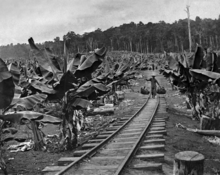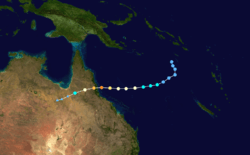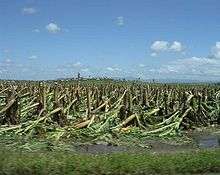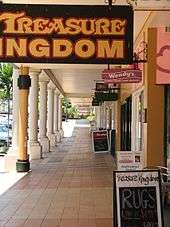Innisfail, Queensland
| Innisfail Queensland | |||||||||||||||
|---|---|---|---|---|---|---|---|---|---|---|---|---|---|---|---|
|
The township of Innisfail, as seen from Coquette Point | |||||||||||||||
 Innisfail | |||||||||||||||
| Coordinates | 17°31′25″S 146°01′45″E / 17.52361°S 146.02917°ECoordinates: 17°31′25″S 146°01′45″E / 17.52361°S 146.02917°E | ||||||||||||||
| Population | 7,176 (2011 census)[1] | ||||||||||||||
| Established | 1879 [2] | ||||||||||||||
| Postcode(s) | 4860 | ||||||||||||||
| Elevation | 10 m (33 ft)[3] | ||||||||||||||
| Location |
| ||||||||||||||
| LGA(s) | Cassowary Coast Region | ||||||||||||||
| State electorate(s) | Hill | ||||||||||||||
| Federal Division(s) | Kennedy | ||||||||||||||
| |||||||||||||||
| |||||||||||||||
Innisfail (from Irish: Inis Fáil) a town and locality in the Cassowary Coast Region in Far North Queensland, Australia.[4][5] The town was originally called Geraldton until 1910. It is the major township of the Cassowary Coast Region and is well renowned for its sugar and banana industries, as well as for being one of Australia's wettest towns. In March 2006 Innisfail gained worldwide attention when severe Tropical Cyclone Larry passed over causing extensive damage.[6][7] In the 2011 census, the town of Innisfail had a population of 7,176 people.[1]
History
Prior to European settlement the Innisfail area was occupied by five separate societies of the Mamu people. These Aboriginal people followed migratory lifestyles in the rainforest and traversed rivers in string-bark canoes.
The first arrival of European people came in 1872 when survivors of the shipwreck, the "Maria" arrived on the coastal areas surrounding what is now the Johnstone River. Sub-Inspector Robert Arthur Johnstone of the Native Police came with the intention of rescuing remaining survivors and collectively punishing Aboriginals thought to have killed a number of the shipwrecked crew. In mid 1873, Johnstone returned to the area as part of another punitive mission and ventured further upriver between what is today Flying Fish Point and Coquette Point.[8] Johnstone wrote very highly of the area, stating:
A most glorious view appeared - a noble reach of fresh water, studded with blacks with their canoes and catamarans, others on the sandy beaches; deep blue fresh water expanding to an imposing breadth.
— Robert Johnstone (1873), [2]

In October 1873, Johnstone again returned as part of the Northeast Coast Expedition led by the explorer George Elphinstone Dalrymple. British settlement was first established at the junction of the north and south branches of the Johnstone River by this expedition on the 5th October 1873. It was named Nind's Camp after Philip Henry Nind who accompanied the party.[9]
Later in 1879, Irishman Thomas Henry FitzGerald arrived in the area to establish a sugar industry. He was accompanied by large numbers of Kanaka South Sea Islanders workers accompanied by smaller numbers of Irish labourers. The house built by FitzGerald and thus the first establishment in the area was called Innisfallen, after the largest island in the Lakes of Killarney, Ireland. Inis Fáil (Island of Destiny) is an ancient Irish name for Ireland itself.[4] The name is used in the rarely-sung third verse of "The Soldier's Song", the Irish national anthem. The stone mentioned may be the stone at Tara, Co Meath, at which high kings of Ireland were crowned.

From 1879, the settlement was named Geraldton after FitzGerald, but in 1910 was renamed "Innisfail" to avoid confusion with the town of the same name in Western Australia.[10]
Johnstone River Post Office opened on 1 November 1882 (a receiving office had been open from 1880), was renamed Geraldton two months later and Innisfail in 1910.[11]
%2C_22_September_1885.jpg)
In May 1885, the Queensland Government called for tenders to build the Geraldton Hospital to replace the existing tent hospital;[12] however, the tenders submitted were more expensive than the government was willing to pay, so they called again for tenders in September 1885 resulting in a contract with E. Couchman for £1527.[13][14]
In 1906 Patrick Leahy established the Johnstone River Advocate newspaper. Later it was renamed the Johnstone River Advocate and Innisfail News, the Evening Advocate, and the Innisfail Chronicle. The newspaper continues to be published as the Innisfail Advocate.[15]
The 1920s and 1930s saw the beginning of a major period of settlement by Italian immigrants and noteworthy populations from Greece and Malta. Later in this period populations from Yugoslavia, India and the Philippines would also settle in the area.[2][16]
Local rugby league footballer Kerry Boustead was the only player from outside the Sydney and Brisbane Leagues selected to represent Australia on the 1978 Kangaroo tour.

The Innisfail War Memorial in Jack Fossey Park on Fitzgerald Esplanade was dedicated on 16 April 2005; it commemorates those who served in all wars.[17]
In the 2006 census, Innisfail had a population of 8,262 people.[18]
Today the town still boasts many good examples of the Art Deco and Streamline Moderne styles of architecture.
Innisfail State School opened on 18 July 1887 and Innisfail East State School opened on 3 February 1936. Innisfail State High School was open from 24 January 1955 until 2009 when it was amalgamated with the Innisfail Inclusive Education Centre - A State Special School and Tropical North Queensland TAFE (Innisfail Campus) to form Innisfail State College[19]
Heritage listings
Innisfail has a number of heritage-listed sites, including:
- 10 Edith Street: Innisfail Courthouse[20]
- 134 Edith Street: See Poy House[21]
- Fitzgerald Esplanade: Canecutters Memorial[22]
- 70 Rankin Street: Johnstone Shire Hall[23]
- 90 Rankin Street: Mother of Good Counsel Catholic Church
- 114 Rankin Street: St Andrew's Presbyterian Memorial Church[24]
Culture
Innisfail is diverse. There are populations of indigenous Australians, Europeans (in particular Italians), South Asians and East Asians (in particular Hmongs).[25][26][27]
Popular annual events to celebrate Innisfail's diversity include:[28]
- Kulture Karnival
- Festival Innisfail
- Feast of the Senses
- Feast of the Three Saints
In 2001 Los Angeles band Sugar Ray filmed part of their music DVD "Music in High Places" at the Johnstone Crocodile Farm in Innisfail.
The township has only 2 secondary schools: Good Counsel College and Innisfail State College and a single business district.
There are many events that act predominantly as community events, the main ones include:
- The Innisfail Rodeo
- Harvest Festival
- Annual Show
While Innisfail was always reputed to have a positive sense of community spirit, the aftermath of Tropical Cyclone Larry and the unified cleanup effort acted to promote this spirit through shared suffering.[29]
Facilities
The Cassowary Coast Regional Council operates a public library at 49 Rankin Street. [30] The current library opened in 2015.[31]
Religion
Chinese Australians built the Innisfail Temple/Lit Sing Gung (列聖宮) in Owen Street, which is now open to other races and religions.
Geography
Innisfail's town centre is situated at the junction of the North and South Johnstone Rivers, approximately 5 km (3 mi) from the coast.[32] It is located near large tracts of old-growth tropical rainforest surrounded by vast areas of extensive farmlands. Queensland's highest mountain, Mount Bartle Frere; part of Australia's Great Dividing Range, is 15 kilometres (9 mi) to the north.[33]
Climate
Innisfail experiences a tropical rainforest climate (Köppen climate classification Af) as it has no month with a mean temperature below 18 °C (64.4 °F) or with less than 60 millimetres (2.4 in) of rainfall.[34] Consistently, humid, very warm to hot weather dominates in Innisfail. In particular Innisfail is reputed as being among the wettest towns in Australia.[35] Babinda, 30 kilometres (19 mi) north of Innisfail is generally considered to be the wettest. Unlike most of tropical Australia,[36] the southern winter or "dry" season is not completely dry as moist easterly winds bring frequent showers;[37] rainfall is, however, still far lower than during the southern summer. Monthly totals of over 1,000 mm (39 in) are a routine occurrence in the region between January and April and some months will not experience a day without rain if the monsoon is unusually heavy. The town gets around 71.8 clear days per year.[3]
| Climate data for Innisfail (1881-2012) | |||||||||||||
|---|---|---|---|---|---|---|---|---|---|---|---|---|---|
| Month | Jan | Feb | Mar | Apr | May | Jun | Jul | Aug | Sep | Oct | Nov | Dec | Year |
| Record high °C (°F) | 40.1 (104.2) |
38.8 (101.8) |
37.8 (100) |
34.2 (93.6) |
31.2 (88.2) |
29.5 (85.1) |
30.0 (86) |
30.4 (86.7) |
32.2 (90) |
35.6 (96.1) |
38.8 (101.8) |
40.3 (104.5) |
40.3 (104.5) |
| Average high °C (°F) | 30.8 (87.4) |
30.6 (87.1) |
29.8 (85.6) |
28.3 (82.9) |
26.4 (79.5) |
24.5 (76.1) |
24.1 (75.4) |
25.1 (77.2) |
26.7 (80.1) |
28.4 (83.1) |
29.7 (85.5) |
30.8 (87.4) |
27.9 (82.2) |
| Daily mean °C (°F) | 26.8 (80.2) |
26.8 (80.2) |
26.0 (78.8) |
24.4 (75.9) |
22.4 (72.3) |
22.5 (72.5) |
19.7 (67.5) |
20.3 (68.5) |
21.8 (71.2) |
23.7 (74.7) |
25.3 (77.5) |
26.4 (79.5) |
23.6 (74.5) |
| Average low °C (°F) | 22.8 (73) |
22.9 (73.2) |
22.1 (71.8) |
20.5 (68.9) |
18.3 (64.9) |
16.2 (61.2) |
15.2 (59.4) |
15.4 (59.7) |
16.9 (62.4) |
19.0 (66.2) |
20.8 (69.4) |
22.0 (71.6) |
19.3 (66.7) |
| Record low °C (°F) | 17.2 (63) |
18.0 (64.4) |
17.2 (63) |
10.5 (50.9) |
9.4 (48.9) |
6.5 (43.7) |
6.2 (43.2) |
8.2 (46.8) |
10.1 (50.2) |
12.2 (54) |
16.0 (60.8) |
17.2 (63) |
6.2 (43.2) |
| Average rainfall mm (inches) | 511.7 (20.146) |
597.2 (23.512) |
667.4 (26.276) |
460.3 (18.122) |
299.5 (11.791) |
187.4 (7.378) |
136.1 (5.358) |
117.4 (4.622) |
86.8 (3.417) |
88.3 (3.476) |
159.7 (6.287) |
264.8 (10.425) |
3,569.6 (140.535) |
| Average rainy days (≥ 0.2 mm) | 16.8 | 17.3 | 19.8 | 18.9 | 17.0 | 13.2 | 12.1 | 10.6 | 8.9 | 8.2 | 10.2 | 12.4 | 165.4 |
| Average afternoon relative humidity (%) | 72 | 74 | 73 | 73 | 72 | 70 | 69 | 66 | 65 | 65 | 67 | 69 | 70 |
| Mean monthly sunshine hours | 201.5 | 155.4 | 170.5 | 165.0 | 142.6 | 165.0 | 173.6 | 198.4 | 222.0 | 254.2 | 240.0 | 229.4 | 2,317.6 |
| Source #1: Bureau of Meteorology[3] | |||||||||||||
| Source #2: Sunshine statistics sourced from South Johnstone Exp Station (9.7km away)[38] | |||||||||||||
Cyclones
Innisfail is consistently under threat from tropical cyclones developing in the Coral Sea in and around summer months.[39] Furthermore, high rainfall associated with aforementioned cyclones and monsoons, combined with Innisfail settlement on adjoining rivers causes flooding to be commonplace, occurring to varied degrees of severity annually.[40] Innisfail suffered extensive damage in 2006 due to Cyclone Larry as the site of landfall and received over 100mm of rain in the span of three hours.


Tropical Cyclone Larry, an Australian Category 5 cyclone, struck the locality at 7am on 20 March 2006, with the eye of the storm passing over the town.
Severe structural damage occurred over the entirety of the township, the main damage being a portion of houses losing roofs and windows and the cyclone rendered even more homes structurally unsound. Power was effectively eliminated from the town and generators became a luxury in many homes. Clean drinking water was also compromised in many homes leading to health fears. The swift response of the Australian Defence Force was praised by many and the cleanup campaign they orchestrated allowed for total utilities restoration within 3 weeks. Severe damage was done to crops and plantations (mainly bananas) which had a serious economic impact on the region. Only one indirect death was record as a result of the cyclone.
Cyclone Larry was a direct and primary cause of the widely reported and dramatic surge in banana prices in Australia. Inflated cost remained until farmers were able to meet demand again in early 2007. In February 2011 Cyclone Yasi hit Innisfail.[41][42][43]
In 2011, in the early morning of 3 February, Cyclone Yasi crossed the far north Queensland coast causing damage to the Innisfail area. Although the damage was not as severe as Cyclone Larry, Cyclone Yasi still had a huge impact on Innisfail bringing strong winds of possibly 285 kilometres per hour.[44]
Council controversy

On 8 February 2007 the Johnstone Shire Council was sacked by the Queensland State Government by Queensland's Local Government Minister, Andrew Fraser because of internal conflict, inappropriate behaviour and financial problems, despite an issued show cause presented on 2 August 2006.[45][46]
Among the perceived gross misconduct were the following incidences:
- The purchase of a $250 000 Steinway Model D Piano with insurance money from Cyclone Larry.[47]
- Former Deputy Mayor George Pervan was quoted on commercial radio during an interview during the aftermath of Cyclone Larry requesting Southern Queenslanders to:
"Send up a truckload of piss so we can all get fucking drunk" - George Pervan - 2006 [48]
While 2 councillors had attempted to get the Queensland Government to revoke the decision Andrew Fraser has stated that while the action is regrettable it was indeed the correct decision.[49]
Innisfail today
At present Innisfail has largely recovered from the devastation of Cyclone Larry. After the cyclone the township underwent something of an economic boom that stemmed from an influx of tradespeople and business eager to capitalize upon relatively significant insurance payouts. According to reports local trade had increased some 30 - 40% opposed to expected increases of 10%.[50] [51]
The main industries remain predominately banana and sugar cane and have since recovered from the natural disaster. Outlying areas of Innisfail have also resumed manufacture of tea, pawpaws and other exotic fruits.[52]
Innisfail remains a popular destination for backpackers seeking employment in the fruit picking industry. Tourism is of importance to the township and the town consistently seeks to attract visitors passing through on the Bruce Highway.[53]
Notable residents

- Scott Bolton, rugby league player for the North Queensland Cowboys, grew up in Innisfail.
- Kerry Boustead: former Queensland and Australian Rugby league great, Queensland's first ever try scorer in State of Origin rugby league
- Jessica-Rose Clark, mixed martial artist currently signed to the UFC.
- Steve Corica: retired footballer who was capped numerous times for Australia and played in England, notably for Wolverhampton Wanderers, was also capped over 100 times for Marconi Stallions in the ex-NSL and Sydney FC in the A-League.
- Brent Cockbain former international rugby player (2003 World cup for Wales) grew up in Innisfail.
- Joseph Costa, BMX rider, grew up in Innisfail. Costa is a consistent BMX competitor.[54]
- Ben Dunk,born 1987 Australia T20 and ODI cricket player
- Karl Gehringer, former Australian National and Commonwealth team Greco-Roman Wrestling 2005-2006, went to school in Innisfail [55]
- Shannon McCann, Australian 100m Hurdler competed at the 2014 Commonwealth Games, grew up in Innisfail[56]
- Billy Slater, rugby league player for the Melbourne Storm, Queensland, and Australia, grew up in Innisfail
- Norman Stevens, Australian boxer at 1980 Moscow Olympics
- Ty Williams, former rugby league player for the North Queensland Cowboys and Queensland grew up in Innisfail. Williams returned to Innisfail to captain/coach the Innisfail Leprechauns in 2014.
In popular culture
- Elizabeth Haran's 2003 novel Sunset over Eden is set in the town.
See also
References
- 1 2 Australian Bureau of Statistics (31 October 2012). "Innisfail (UCL)". 2011 Census QuickStats. Retrieved 26 March 2016.

- 1 2 3 "Walkabout - Innisfail". Archived from the original on 30 June 2006. Retrieved 2 June 2006.
- 1 2 3 "Innisfail - Australian Bureau of Meteorology statistics". Retrieved 2 June 2006.
- 1 2 "Innisfail - town (entry 40993)". Queensland Place Names. Queensland Government. Retrieved 27 March 2016.
- ↑ "Innisfail - location (entry 45710)". Queensland Place Names. Queensland Government. Retrieved 27 March 2016.
- ↑ "Tourism and Regional Information". Retrieved 2 June 2006.
- ↑ "Australian Bureau of Meteorology Severe Tropical Cyclone Larry Report". Archived from the original on 22 September 2012. Retrieved 2 June 2006.
- ↑ "SKETCHER". The Queenslander (1984). Queensland, Australia. 19 March 1904. p. 2 (Unknown). Retrieved 3 September 2018 – via National Library of Australia.
- ↑ "SKETCHER". The Queenslander (2015). Queensland, Australia. 22 October 1904. p. 8. Retrieved 4 September 2018 – via National Library of Australia.
- ↑ "CHANGE OF NAME". Cairns Post (Qld. : 1909-1954). Qld.: National Library of Australia. 19 August 1910. p. 5. Retrieved 9 March 2011.
- ↑ Premier Postal History. "Post Office List". Premier Postal Auctions. Retrieved 10 May 2014.
- ↑ "OFFICIAL NOTIFICATIONS". The Brisbane Courier. XXXIX, (8, 527). Queensland, Australia. 9 May 1885. p. 3. Retrieved 21 October 2017 – via National Library of Australia.
- ↑ "JOHNSTONE RIVER". The Brisbane Courier. XL, (8, 635). Queensland, Australia. 14 September 1885. p. 3. Retrieved 21 October 2017 – via National Library of Australia.
- ↑ "Official Notifications". The Queenslander. XXVIII, (522). Queensland, Australia. 26 September 1885. p. 504. Retrieved 22 October 2017 – via National Library of Australia.
- ↑ "Historical Notes on North Queensland Newspapers". www.jcu.edu.au. Retrieved 2015-12-02.
- ↑ "History of the Innisfail Region". Retrieved 2 June 2006.
- ↑ "Innisfail Cenotaph". Monument Australia. Retrieved 5 April 2014.
- ↑ Australian Bureau of Statistics (25 October 2007). "Innisfail (Urban Centre/Locality)". 2006 Census QuickStats.
- ↑ "Opening and closing dates of schools in Queensland". Education Queensland. Retrieved 2 February 2018.
- ↑ "Innisfail Court House (entry 601578)". Queensland Heritage Register. Queensland Heritage Council. Retrieved 7 July 2013.
- ↑ "See Poy House (entry 602759)". Queensland Heritage Register. Queensland Heritage Council. Retrieved 7 July 2013.
- ↑ "Canecutters Memorial (entry 602041)". Queensland Heritage Register. Queensland Heritage Council. Retrieved 7 July 2013.
- ↑ "Johnstone Shire Hall (entry 601579)". Queensland Heritage Register. Queensland Heritage Council. Retrieved 7 July 2013.
- ↑ "St Andrew's Presbyterian Memorial Church (entry 602332)". Queensland Heritage Register. Queensland Heritage Council. Retrieved 7 July 2013.
- ↑ "SRA Fact Sheet Innisfail - Australian Government". Archived from the original on 27 April 2006. Retrieved 2 June 2006.
- ↑ "Innisfail Pioneers - Italian History" (PDF). Retrieved 2 June 2006.
- ↑ "Cultural Diversity in the Johnstone Shire Council". Archived from the original on 29 September 2007. Retrieved 2 June 2006.
- ↑ "About Johnstone Shire Council". Archived from the original on 15 June 2005. Retrieved 2 June 2006.
- ↑ "Community Spirit - Winter 2007". Archived from the original on 28 September 2007. Retrieved 2 June 2006.
- ↑ "Innisfail Library". Public Libraries Connect. 10 January 2018. Retrieved 19 January 2018.
- ↑ "Queensland Public Libraries Statistical Bulletin 2016-17" (PDF). Public Libraries Connect. November 2017. Retrieved 19 January 2018.
- ↑ "Innisfail - Google Maps". Retrieved 2 June 2006.
- ↑ "Mt. Bartle Frere Trail". Archived from the original on 18 June 2006. Retrieved 2 June 2006.
- ↑ Linacre, Edward; Geerts, Bart (1997). Climates and Weather Explained. London: Routledge. p. 379. ISBN 0-415-12519-7.
- ↑ "Tully - Cairns Connect". Retrieved 2 June 2006.
- ↑ Median Rainfall for July
- ↑ See Mean rainfall May to September for an explanation
- ↑ "Summary statistics SOUTH JOHNSTONE EXP STN (mean daily sunshine hours)". Bureau of Meteorology. May 2012. Retrieved 4 July 2012.
- ↑ "List of Queensland Cyclones - Windworker Roof Renovations". Retrieved 2 June 2006.
- ↑ "Flood Warning system for the Johnstone River". Retrieved 2 June 2006.
- ↑ "ABC news - Innisfail Devastated". Retrieved 2 June 2006.
- ↑ "Australian Banana Growers Council - Cyclone Larry Report". Archived from the original on 15 October 2006. Retrieved 2 June 2006.
- ↑ "Sydney Morning Herald - Disaster drives big price surge". The Sydney Morning Herald. 21 March 2006. Retrieved 2 June 2006.
- ↑ "Severe Tropical Cyclone Yasi". Bureau of Meteorology. Bureau of Meteorology. Retrieved 2 February 2017.
- ↑ "ABC - Sacking of JSC". Retrieved 2 June 2006.
- ↑ "Queensland Government - Show Cause Issued". Retrieved 2 June 2006.
- ↑ "Innisfail splashes out on $250k piano with insurance money - The Courier Mail". Retrieved 2 June 2006.
- ↑ "News.com.au - Sacked Council gone bananas". Retrieved 2 June 2006.
- ↑ "ABC news story - 'Ineffective Council Sacked'". Retrieved 2 June 2006.
- ↑ "Innisfail Business booming after cyclone - ABC report". Retrieved 2 June 2006.
- ↑ "APIA set up in Innisfail". Archived from the original on 19 August 2006. Retrieved 2 June 2006.
- ↑ "Australian Tropical Fruits". Archived from the original on 4 May 2006. Retrieved 2 June 2006.
- ↑ "Innisfail tourism". Archived from the original on 31 December 2012. Retrieved 2 June 2006.
- ↑ "Joseph Costa". Rival Racing. Retrieved 16 September 2014.
- ↑ "Geringer, Karl". International Federation of Associated Wrestling Styles. Archived from the original on 14 July 2014. Retrieved 22 June 2014.
- ↑ "Shannon McCann". Glasgow 2014 Ltd. Retrieved 11 June 2017.
External links
| Wikimedia Commons has media related to Innisfail, Queensland. |
- University of Queensland: Queensland Places: Innisfail
- Innisfail Homepage
- Detailed History of Innisfail
- Cassowary Connect Local Events Website for Innisfail